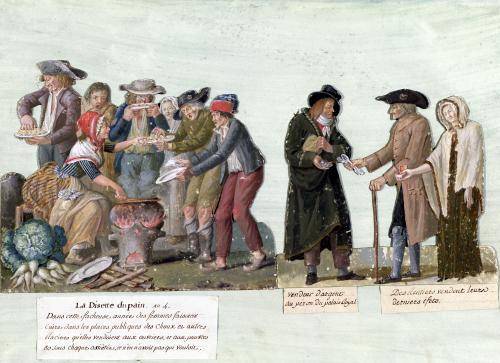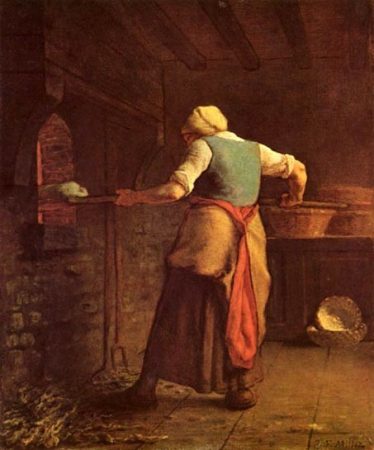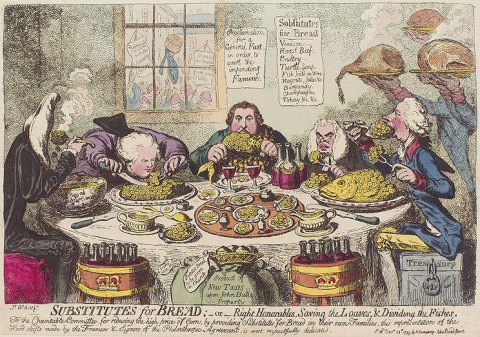
Harvest failures, high food prices and hunger all shaped the course of the French Revolution, particularly for the working classes. Inefficient farming methods, adverse weather events and an increasing population meant that by the 1780s, France was struggling to regularly produce enough food to feed itself.
An agrarian economy
Agriculture dominated France’s domestic economy, accounting for around 75 percent of all production and 70 percent of land use. Freehold peasant farmers owned around 40 percent of agricultural land. The remainder was owned by the nobility (25 percent), bourgeoisie (25 percent) and the church (10 percent), who distributed it as tenancies.
Agricultural production in 18th-century France had changed little since the Middle Ages. Farming was still labour intensive, carried out by hand or with beasts of burden. Little was known of agronomy or effective fertilisation. The soil was replenished with manure and periodically rested. This meant productivity was poor and crop yields were low.
Food harvests were also susceptible to unpredictable factors – climate events like unseasonably cold or dry weather, drought or hail, outbreaks of crop diseases or insect plagues.
An increasing population
These post-medieval cycles and methods of farming shaped the lives of France’s lower classes. The size of a harvest determined how peasants would live in the coming year. When the season’s wheat, corn or rye was harvested, most of it was retained for subsistence, feudal dues, seed grain and winter stores. Whatever was left was sold at market or to wholesalers.
The market economy was relatively straightforward: if crops failed or yields were lower than expected, less food reached markets in the cities and towns. Any shortages of food would drive up demand and prices.
In the 17th and early 18th centuries, scarcity and high food prices were relatively infrequent. Demographic changes in the 18th century placed new pressures on farmers. France in 1700 had a population of just under 20 million but by the 1780s, it was approaching 28 million. The population of cities and towns had also grown, Paris increasing from 500,000 to 650,000 people in the same period.
Agricultural growth, in contrast, had been negligible. Production increased by 10 to 20 percent in some regions but hardly at all in others. In short, France had eight million more mouths to feed – but its agricultural productivity had not kept pace with its population growth.
“The [French] country is a heap of ashes. Grass is scarcely to be seen and all sorts of grain is short, thin, pale and feeble, while the flax is quite dead… I pity this people from my soul… No green peas, no salad, no vegetables to be had upon the road, and the sky is still as clear, dry and cold as ever. The flocks of sheep and herds of cattle stalk about the fields like droves of walking skeletons.”
John Adams, US diplomat, 1775
The dire 1780s
As mentioned previously, farmers in pre-revolutionary France were also at the mercy of the weather. Adverse weather events did not have to be prolonged or occur nationwide to affect the entire nation’s food supply. Drought, flooding rainfalls or severe frosts could wipe out an entire harvest in a major crop-growing region, driving up the demand for crops from other regions.
France’s food supplies were affected by poor harvests in 1769, 1770, 1775 and 1776. The last of these coincided with Anne-Robert Turgot‘s proposed reforms to free up the grain trade. Between 1777 and 1781, France enjoyed a string of warm dry summers that produced excellent harvests. Cereal and grape harvests were particularly strong, allowing bread and wine prices to hold firm or drop slightly.
In contrast, the 1780s were dire for French farmers. In 1782, a long winter and wetter than average spring postponed sowing, resulting in a poor harvest. In June 1783, the Laki volcano in Iceland began erupting and spewing ash, dust and sulphur into the atmosphere. This eruption lasted months, clogging the skies over Europe and causing significant drops in temperature. France’s harvests in 1783 and 1784 were consequently poor, as were harvests across most of Europe.
The droughts of 1785 and 1788
France’s problems with adverse weather did not end there. From September 1784, its farmers endured a drought that hampered cereal crops, causing a poor harvest in 1785 and a below-average yield the following year. Normal conditions returned in 1787 when there was a bumper harvest.
The rain dried up again in early 1788, however, and by May around three-quarters of the nation was in drought. The food bowl regions of northern and northwestern France received almost no rainfall for months; the ground could scarcely be furrowed and whatever was planted quickly died.
To make matters worse, crops and vegetables in the north-west and the districts around Paris were decimated by severe hailstorms on July 13th 1788, a year and a day before the fall of the Bastille. According to chroniclers like the Englishman Arthur Young, on this day “hail fell as large as a quart bottle”, killing several people, macerating crops and destroying trees.

Freezing winters
The poor harvest of 1788 was compounded by the winter that followed, which was the coldest in decades. From late November to March, much of northern France suffered constant freezing temperatures, ice and snow. Paris reportedly suffered 57 straight days of frost.
The bitter winter killed off fruit trees and spoiled stored grain and vegetables. It turned barrels of wine and cider to icy slush and froze rivers hard, rendering mills and machinery inoperable.
When the cold snap broke in late January and February 1789, thawing ice and snow caused rivers, streams and canals to swell and burst their banks. After weeks of frozen idleness, thousands of French peasants had to contend with flooded fields and granaries, impassable roads and uncrossable waterways. Yet for all the misery in the countryside, it was the cities and towns who would feel the worst of the food shortages.
Critical food shortages

By the start of 1789, France was critically short of food. Jacques Necker, who had been reappointed as director of finances in 1777, was alert to the problem and took steps to avoid a famine. In the autumn of 1788, Necker introduced several emergency measures, banning all food exports and requiring all grain to be sold to official markets. Necker also organised the importation of foreign cereal and grain, totalling around 148,000 tonnes.
While these measures prevented a mass famine, they did not alleviate shortages. The availability of bread in Paris dwindled steadily through late 1788. By January 1789, it had become critical. In February 1789, city officials increased the price of bread from nine sous to 14.5 sous for a four-pound loaf.
This price increase pushed Parisian workers to the brink of despair. In 1788, an unskilled labourer in Paris spent around half his daily wages on bread. Now, in the spring of 1789, he was spending between 70 and 90 percent. Some wages did increase slightly but nowhere near enough to match rapid increases in the price of food.

1. Harvest failures contributed to revolutionary sentiment by leaving the nation short of food crops, which created bread shortages and drove up prices, particularly in France’s towns and cities.
2. Farmers in 18th century France used antiquated labour intensive methods that did not produce large yields, plus they were susceptible to adverse weather conditions.
3. The 1780s was a particularly poor decade for harvests, caused by heavy rains, severe droughts, a volcanic eruption in 1783 and a July 1788 hailstorm that decimated a large volume of crops.
4. In 1788-89 the national government took action to prevent a famine, however by the start of 1789 the nation’s cities found themselves critically short of food.
5. These shortages were particularly acute in Paris, where bread prices increased from eight sous to 14.5 sous, or between 70 and 90 percent of the daily wage of an unskilled worker.
Citation information
Title: ‘Harvest failures’
Authors: Jennifer Llewellyn, Steve Thompson
Publisher: Alpha History
URL: https://alphahistory.com/frenchrevolution/harvest-failures/
Date published: September 21, 2019
Date updated: November 8, 2023
Date accessed: July 27, 2024
Copyright: The content on this page is © Alpha History. It may not be republished without our express permission. For more information on usage, please refer to our Terms of Use.
